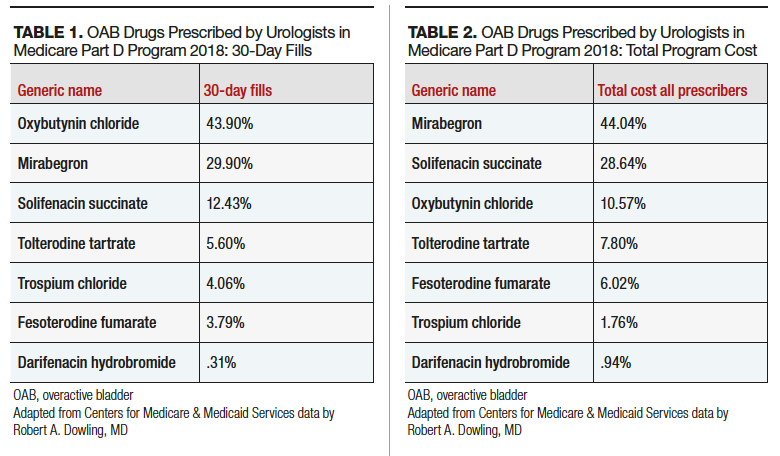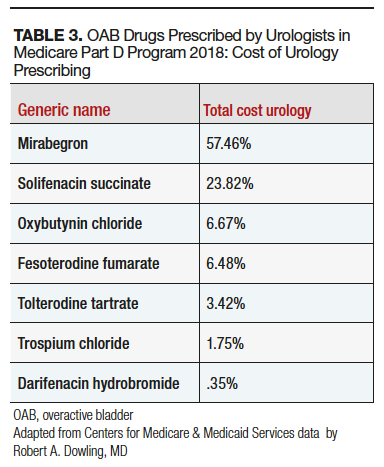Article
Tamsulosin tops list of Part D drugs prescribed by urologists
Author(s):
Finasteride, oxybutynin chloride, and mirabegron also rank high in latest data from CMS.
Robert A. Dowling, MD

Increased drug costs and spending for Medicare beneficiaries have been an area of concern for patients, their physicians, policy makers, and regulators for several years. Medicare pays for most drugs through either the Part B program (generally injectable medications purchased by providers and administered in a clinical setting) or the Part D program (generally prescribed oral and patient-administered medications). A previous article discussed the most common Part D drugs prescribed by urologists from a program and cost perspective.1 This article discusses them from a prescribing (and sometimes dispensing) perspective.

The Centers for Medicare & Medicaid Services (CMS) recently released detailed provider Part D drug prescribing and utilization data for 2018.2 It is important to remember that only approximately two-thirds of Medicare beneficiaries are enrolled in Part D, and prescribing patterns in this program may not be generalizable to all patients in your practice. Total spending in 2018 for the Part D program was $168 billion, up more than 10% from 2017. The total cost is based on the amount paid by the Part D plan, the Medicare beneficiary, government subsidies, and any other third-party payers. Total cost for 9944 unique urologists’ prescribed part D drugs was more than $1.5 billion, or 0.9% of the total program cost. Eleven drugs account for 80% of this spending. The drugs most frequently prescribed by urologists (measured in 30-day fills) were tamsulosin (7,462,775), followed by finasteride (4,791,306), oxybutynin chloride (1,557,233), and mirabegron (Myrbetriq) (1,060,529). The drug with the highest urology spend was mirabegron ($373,568,075), followed by enzalutamide (Xtandi) ($225,705,747), solifenacin succinate (VesIcare) ($154,886,101), and abiraterone acetate (Zytiga) ($140,410,379).

Drugs prescribed for overactive bladder (OAB) illustrate the nuances of perspective when looking at the data. From a clinical utilization standpoint, oxybutynin is the most commonly prescribed drug by urologists in this class (44%) followed by mirabegron (30%), solifenacin (12%), tolterodine (Detrol LA, Detrol) (6%) and others (Table 1). From a payer perspective (CMS, in this case), mirabegron is the largest spend across all specialties ($1.06 billion, 44% of dollars), followed by solifenacin succinate ($692 million, 29%), oxybutynin ($255 million, 11%), tolterodine ($188 million, 8%) and others (Table 2). From a specialty perspective, urologists prescribe only 27% of dollars in this class: 35% of mirabegron, 22% of solifenacin succinate, 17% of oxybutynin, 29% of fesoterodine fumarate (Toviaz), and 27% of trospium chloride (Sanctura). Finally, 57% of the urology prescribing Part D costs for these OAB drugs was “spent” on mirabegron (Table 3). The patient’s perspective is difficult to generalize, as there are many different plans with different formularies and different cost-sharing structures; generally, the more expensive drugs will cost the patient more and propel them faster to the “coverage gap” (also known as the doughnut hole). In 2018, the spending threshold to enter the gap was $3750, and the patient then assumed 35% of brand-name drug costs until they reached $5000. Individuals enrolled in Medicare Part D plans typically know a lot about the cost of their prescription drugs—because they pay a share.
Surprising trends
Urologists might be surprised to know that in 2018 they collectively prescribed less than 5% of sildenafil (Viagra), 10% of abiraterone acetate, and less than 20% of enzalutamide in the Part D program. These are drugs that are commonly dispensed in some urology practices, and urologists are recognized as the experts in prostate cancer, OAB, and men’s health. The drug-prescribing data reflect the reality that urologists prescribed a minority of the medical treatments for these conditions in the Medicare Part D program in 2018.
Did you know you can find your own data? Go to https://data.cms.gov/d/mhdd-npjx/visualization. In the filter area, type in either your name or your national provider identifier number. Your detailed prescribing data are available so you can see how your numbers compare with the aggregate statistics.
Bottom line: Drug costs to the Medicare Part D program as a whole continue to increase each year, but urology accounts for less than 1% of the spending in this program in the most recent available data (2018). Expensive oral drugs are under close scrutiny—especially if there are generic equivalents—and urologists prescribe and, in some cases, dispense some of these drugs. Urologists should be familiar with the costs under their direct or indirect control and their contribution to this important part of health care expenditures in the Medicare program.
Dowling is the president of Dowling Medical Director Services, a private health care consulting firm specializing in quality improvement, clinical informatics, and health care policy affecting specialty care. He is the former medical director of a large, metropolitan single-specialty urology group in Fort Worth, Texas.
References
1. Dowling RA. Twelve Part D urology meds top $100 million in spending. Urology Times®. July 16, 2019. Accessed April 2, 2021. https://bit.ly/3dNoXL7
2. Part D prescriber data CY 2018. Centers for Medicare & Medicaid Services. Updated December 3, 2020. Accessed April 2, 2021. https://go.cms.gov/2Qe6oHz

















